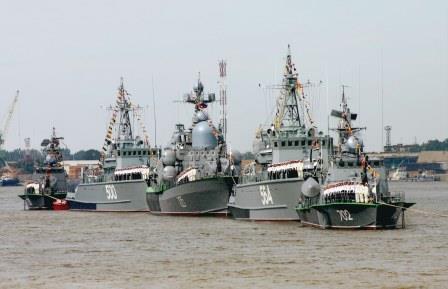
Moscow Moving 15 Warships From Caspian Sea to Waters off Ukraine
Publication: Eurasia Daily Monitor Volume: 18 Issue: 59
By:

The Russian Ministry of Defense announced today (April 13) that Moscow is sending 15 naval vessels from its Caspian Flotilla to waters off Ukraine to take part in military exercises there. Earlier, Russian and Ukrainian media had reported stories about a smaller number. Although the vessels must pass through a 100-kilometer-long canal with more than 13 locks, they will likely be able to arrive before other ships, sent from Russia’s Baltic Fleet, make it to the Black Sea basin. Moreover, although the ships are smaller and less heavily armed than the ones coming from the Baltic, the Caspian Flotilla has, over the last several years, developed a landing capability that could make it a central element in any new Russian invasion of Ukraine from the sea (RIA Novosti, April 13, 2021; see EDM, June 7, 2018).
Moscow is playing up this move as well as the concurrent transfer of armored units from the eastern parts of the North Caucasus to Russian-occupied Crimea (Vzglyad, April 13; Mishen24, April 10). Analysts, however, are divided on whether this movement of the Caspian Flotilla vessels and related shore units is simply part of an effort to blackmail Ukraine and its Western supporters, whether it is a response to Turkey’s decision to allow North Atlantic Treaty Organization (NATO) warships to traverse the Turkish Straits and enter the Black Sea, or if it represents the final stages of Russian preparations for a full-scale invasion of Ukraine (Rosbalt, April 2; Avia.pro, April 10; Sudebno-Yuridicheskaya Gazeta, April 11).
Obviously, the answers to those larger questions depend on Moscow’s larger plans for operations regarding Ukraine. But two analysts have focused on what the role of the Caspian Flotilla may mean. In comments for the Kavkazsky Uzel news agency, independent Russian security analysts Aleksandr Golts and Pavel Felgenhauer link what is happening with the ships of the Flotilla to the increasing activity of NATO forces in the Black Sea (Kavkazsky Uzel, April 10). Golts stressed that the respective Russian ships themselves “are not a powerful strike force and are relatively small.” Larger vessels simply could not pass through the canals as the 15 are doing now. Consequently, he argued, the decision to transfer the Caspian Flotilla vessels is a form of Russian “saber rattling,” designed to send a message that Moscow could, if it chose to, launch “a major military operation.”
The three larger warships coming from the Baltic Sea, the Minsk, the Kaliningrad and the Korolyev, as well as the smaller Boykiy, have greater punch, but they cannot arrive as quickly as the Caspian Flotilla vessels and cannot perform the same functions as the smaller ships from the Caspian can, Golts suggested. Felgenhauer agreed, although he emphasized that even the smaller Caspian vessels could introduce troops and equipment for an invasion of Ukraine.
A precedent exists for Moscow using ships from the Caspian Sea to put pressure on Ukraine without following that up with any new invasion. In May 2018, though with much less ceremony than today, Moscow quietly shifted five Caspian Flotilla vessels to the Sea of Azov, a move the Russian authorities cast then as needed to defend against a Ukrainian attack on occupied Crimea and to ensure that Moscow could protect its shipping in the region against any assault (see EDM, May 31, 2018). After tensions eased, Moscow withdrew those Caspian Flotilla ships and relied instead on its own coastal vessels in the Sea of Azov controlled by the Federal Security Service (FSB) and on a skeleton force of ships operated by the self-proclaimed Donetsk People’s Republic as its own “independent” Azov Flotilla (Svobodnaya Pressa, May 29, 2018).
Once the 15 vessels from the Caspian Flotilla and the 4 from the Baltic Fleet are in place, Russia will have 50 warships in the waters around Ukraine, a force large and powerful enough to counter the NATO vessels that have entered the Black Sea to date. But more worrisome is that the inclusion of the Caspian Flotilla vessels suggests Russian commanders are at least as interested in having a landing capability as they are in projecting a defensive shield against the NATO forces sent in to signal support for Ukraine. That is because, more than any of the other ships involved, those from the Caspian Flotilla have devoted their training to landing troops and equipment either to defend Russian positions under attack or to attack those of others (see EDM, May 31, 2018, November 27, 2018, December 4, 2018, May 28, 2019).
That makes today’s announcement and the dislocation of the Caspian Flotilla vessels to the Black Sea in the next few days a critical indicator of Moscow’s intentions. If these ships are kept in the Sea of Azov, as they largely were three years ago, it would suggest that these Russian naval assets are likely being used as an attempt to intimidate but not necessarily invade. If they are moved further westward, in the direction of Odesa, it would indicate these forces are being put into position for the kind of broad-scale invasion many fear.



